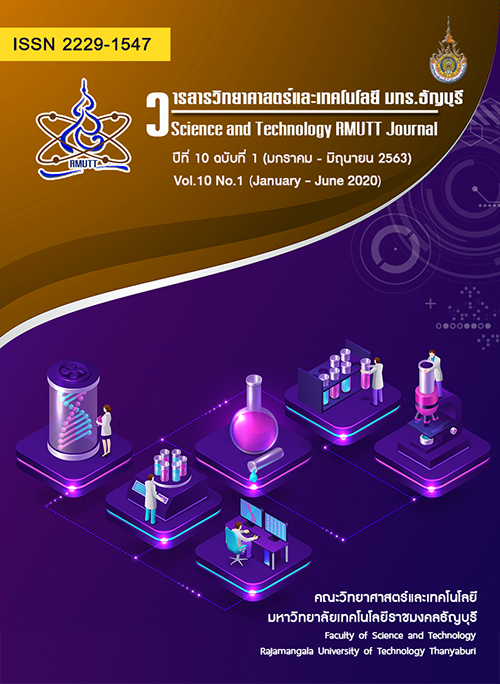Rubber blocks flooring for elder: Effect of pre-vulcanization inhibitor on rubber block flooring properties
Main Article Content
Abstract
This research aimed to study the preparation of Para rubber block flooring for elder. The block flooring composed of two parts such that (i) concrete and (ii) rubber layer. For rubber layer part, the preparation of rubber layer was divided into two sections; (i) the top cover surface based on ethylene propylene diene rubber (EPDM) and (ii) shockproof layer based on natural rubber (NR). The results from the elderly satisfaction surveys on hardness and thickness of rubber layer showed that the most suitable hardness and thickness were 50 Shore A and 10 mm, respectively. The cure time (Tc90) of top cover surface layer based on EPDM compound was 7.30 min, while Tc90 of NR compound was 4.4 min. The significant difference in Tc90 of NR and EPDM compounds was not suitable for forming to block flooring. Therefore, shockproof layer based on NR was studied by varying pre-vulcanization inhibitor (PVI) contents. An increase in PVI content leaded to an increase in Tc90 of NR compound which closed to the Tc90 of EPDM compound. Finally, the rubber block flooring consisted of concrete layer and rubber layer was designed by physical adhesion between rubber layer and concrete.
Article Details
References
มูลนิธิสถาบันวิจัยและพัฒนาผู้สูงอายุไทย. สถานการณ์ผู้สูงอายุไทย พ.ศ. 2561. (ออนไลน์) แหล่งที่มา http://www.thaitgri.org. สืบค้นวันที่ 11 พฤษภาคม 2561.
อารายา เอกปริญญา, สมพิศ ฟูสกุล. รูปแบบพื้นผิวกันกระแทกภายในห้องน้ำสำหรับผู้สูงอายุ. วารสารวิชาการคณะสถาปัตย- กรรมศาสตร์ สจล. 2554. 12: 45-56.
ไพลิน แซ่ลิ้ม. พัฒนายางปูพื้นเพื่อลดการแตกหักของกระดูกสะโพกในผู้สูงอายุ. วิทยานิพนธ์ วิศวกรรมศาสตรมหาบัณฑิต สาขาวิศวกรรมอุตสาหการและระบบ มหาวิทยาลัยสงขลานครินทร์. 2554.
ศุภชัย แก้วจัง. การพัฒนาบล็อกปูพื้นที่ทำจากยางธรรมชาติและ EPDM เหลือ. วิทยานิพนธ์ วิศวกรรมศาสตรมหาบัณฑิต สาขาวิศวกรรมอุตสาหการและระบบ มหาวิทยาลัยสงขลานครินทร์. 2552.
พงษ์ธร แซ่อุย. ยาง: ชนิด สมบัติ และการใช้งาน, พิมพ์ครั้งที่ 2. ศูนย์เทคโนโลยีโลหะและวัสดุแห่งชาติ (เอ็มเทค) สำนักงานพัฒนาวิทยาศาสตร์และเทคโนโลยีแห่งชาติ กระทรวงวิทยาศาสตร์และเทคโนโลยี. 2548.
Sae-oui P., Sirisinha C., Thepsuwan U., Thapthong P. Influence of accelerator type on properties of NR/EPDM blends. Polym Test. 2007. 26(8): 1062-1067.
Nabi H., Ismail H., Azura A. R. Comparison of thermo-oxidative ageing and thermal analysis of carbon black-filled NR/Virgin EPDM and NR/Recycled EPDM blends. Polym Test. 2013. 32(4): 631-639.
Lin T., Ma S., Lu Y., Guo B. New design of shape memory polymers based on natural rubber crosslinked via Oxa-Michael reaction. ACS Appl Mater Inter. 2014. 6: 5695-5703.
Xu C., Cao L., Huang X., Chen Y., Lin B., Fu L. Self-healing natural rubber with tailorable mechanical properties based on ionic supramolecular hybrid network. ACS Appl Mater Inter. 2017. 9: 29363-29373.
Vudjung C. Cure and mechanical properties of natural rubber filled bacterial cellulose. Key Eng Mater. 2016. 705: 40-44.
Boonyod S., Vudjung C. Effect of oleic acid on properties of natural rubber filled bacterial cellulose. Key Eng Mater. 2017. 744: 295-299.






